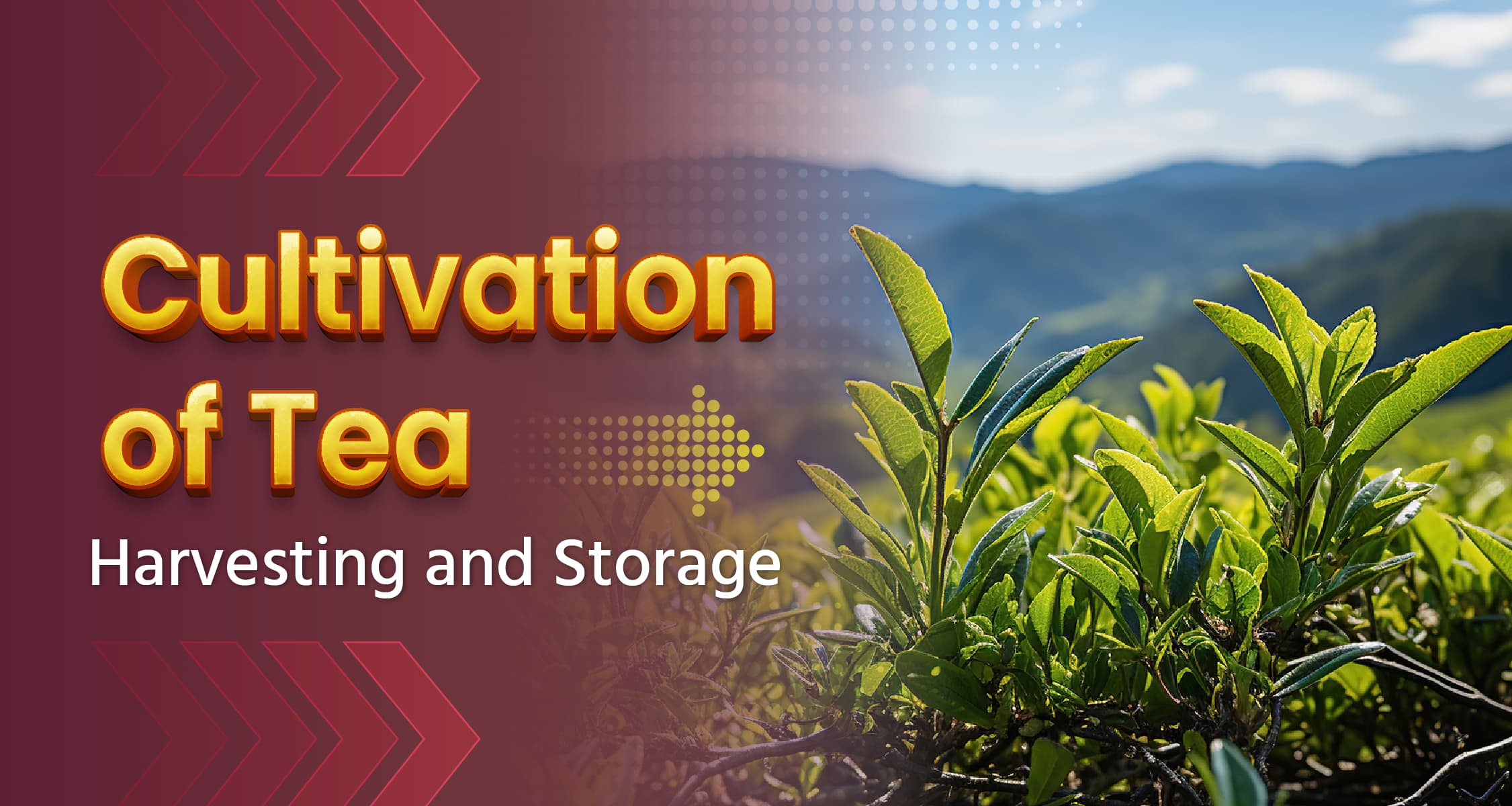Cultivation of Tea: Harvesting & Storage

India ranks 2nd in the world in tea production. Approximately 27% of the world's tea is produced in India. Tea cultivation takes place in states such as Assam, Uttarakhand, Bihar, Manipur, Sikkim, Arunachal Pradesh, Himachal Pradesh, Mizoram, Nagaland, and others. Major tea-exporting countries apart from India include Iran, UAE, USA, UK, Poland, Canada, Saudi Arabia, Egypt, Afghanistan, Bangladesh, China, Singapore, Sri Lanka, Kenya, Japan, Pakistan, and Australia. In 2020-21, India produced approximately 27 million tons of tea. However, harvesting and storage are crucial in tea cultivation, as they can significantly impact the quality and flavor of the final product and here in this post, we will go through its details. thoroughly.
Harvesting & Storage of Tea
Tea Harvesting
Tea leaves are harvested by hand or tools, depending on the variety and region. The timing of the harvest also varies according to the variety, with some types being harvested at any time of the year, while others are only harvested during specific seasons.
- Timing: The timing of the harvest depends on the diversity of the tea and the weather conditions. Generally, tea leaves are harvested when they are young and tender, as they have the highest concentration of flavor compounds.
- Plucking: Tea leaves are plucked by hand or tools, depending on the variety and location. Hand plucking is preferred for high-quality tea because it allows for the selection of the youngest and most tender leaves.
- Sorting: After plucking, the tea leaves are sorted to remove any unwanted leaves, stems, or twigs.
- Drying: The sorted tea leaves are then spread out to dry and wither, which reduces their moisture content and makes them more pliable for further processing.
Storage of Tea
After processing, tea leaves are curated to produce various types of tea including black tea, green tea, and oolong tea. The processing method varies based on the type of tea.
- Drying: After processing, tea leaves are dried to remove any remaining moisture and prevent mold growth.
- Packaging: Dried tea leaves are packed in airtight containers to prevent exposure to moisture, light, and air, which can degrade the quality of the tea.
- Storage Conditions: Tea should be stored in cool, dry, and dark places to maintain its quality and flavor. Exposure to heat, light, and moisture can cause tea to lose its aroma and taste.
- Shelf Life: The shelf life of tea depends on its variety and storage conditions. Generally, tea can be stored for up to two years without significant loss of quality or flavor.
Important Information Related to Tea Cultivation
If you are already into tea farming or considering it, this information about tea will be extremely useful for your cultivation.
- In India, tea primarily comes in four types: green tea, black tea, white tea, and oolong tea.
- Varieties like Chinese, Assam, Kangra tea, White Peony, and Silver Needle White Tea are included in their advanced types.
- Tea cultivation is done in two ways: first, through seeds, and second, by preparing plants in nurseries.
- Tea crops are not affected by wild animals, making them more profitable for farmers.
- Once planted, tea bushes can yield crops for many years.
- Its harvesting can be done once every 3 months.
- For tea cultivation, it is advisable to select locations where there is light rainfall throughout the year.
Do you cultivate tea? If yes, how is your experience? Share your answer and experience with us in the comments. Follow the 'Krishi Gyan' channel now for such interesting and important information related to farming. And if you liked the post, don't forget to like and share it with your fellow farmers.
Frequently Asked Questions (FAQs)
Q: How is tea plucking done?
A: Tea leaves are plucked by hand with great skill. This method not only maintains freshness in the leaves but also ensures the flavor of the tea. According to experts, farmers only select the freshest leaves that are ready for plucking.
Q: When is tea plucking done?
A: Approximately a year after planting, the tea leaves are ready to be plucked. Farmers can harvest the crop by plucking at least three times a year.
Q: Where are tea gardens found in India?
A: With around 803 tea gardens, Assam has the highest number of tea gardens in India. Assam alone produces more than half of India's tea. The estimated annual average production of tea in Assam is approximately 630-700 million kg. The major tea-producing districts in the state include Lakhimpur, Kamrup, Golaghat, Sivasagar, Cachar, and Nagaon.
Q: How many times a year is tea plucked?
A: There are four major and two intermediate flushes in India: spring, summer, autumn, and winter are the main ones, with the first intermediate flush occurring between spring and summer, and the second flush occurring between summer and autumn. (Tea plucking seasons are called flushes)
Q: In what soil is tea grown in India?
A: Tea bushes can be grown well in laterite soils rich in humus and organic matter, with good drainage and a warm, sub-tropical to tropical climate. Tea bushes require a moist and warm climate throughout the year, free from frost.
जारी रखने के लिए कृपया लॉगिन करें

फसल चिकित्सक से मुफ़्त सलाह पाएँ
